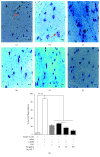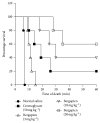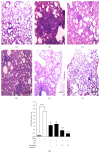Allergic Airway-Induced Hypersensitivity Is Attenuated by Bergapten in Murine Models of Inflammation
- PMID: 30863445
- PMCID: PMC6378071
- DOI: 10.1155/2019/6097349
Allergic Airway-Induced Hypersensitivity Is Attenuated by Bergapten in Murine Models of Inflammation
Abstract
Bergapten (5-methoxypsoralen, 5-MOP) is a plant-derived furocoumarin with demonstrated anti-inflammatory action. The present study investigated its effects on allergic inflammation in two related pathways of mast cell degranulation. Compound 48/80 and lipopolysaccharide (LPS) were used to activate the IgE-independent pathway while bovine serum albumin (BSA) was used as allergen for the IgE-dependent pathway. The modulatory effect of bergapten on mast cell degranulation, neutrophil extravasation, protein concentration, lung histopathology, and oxidative stress was assessed. Bergapten at 10, 30, and 100 μg/ml for 15 min stabilized mast cells in rat mesenteric tissue from disruption in vitro and when administered in vivo at 3, 10, and 30 mg kg-1 for 1 h protected mice from fatal anaphylaxis induced by compound 48/80. Similarly, treatment of LPS-challenged mice with bergapten (3, 10, and 30 mg kg-1) for 24 h significantly decreased neutrophil infiltration into bronchoalveolar lavage fluid, mean protein concentration, and inflammatory cell infiltration of pulmonary tissues when compared to the saline-treated LPS-challenged control. In addition, lung histology of the bergapten-treated LPS-challenged mice showed significantly less oedema, congestion, and alveolar septa thickening when compared to the saline-treated LPS-challenged disease control. LPS-induced oxidative stress was significantly reduced through increased tissue activities of catalase and superoxide dismutase and reduced malondialdehyde levels on treatment with bergapten. In the triple antigen-induced active anaphylaxis, daily administration of bergapten at 3, 10, and 30 mg kg-1 for 10 days, respectively, protected previously sensitized and challenged mice against anaphylactic shock. Overall, our study demonstrates the ability of bergapten to attenuate allergic airway-induced hypersensitivity in murine models of inflammation, suggesting its possible therapeutic benefit in this condition.
Figures





Similar articles
-
Mast cells produce ENA-78, which can function as a potent neutrophil chemoattractant during allergic airway inflammation.J Leukoc Biol. 1998 Jun;63(6):746-51. doi: 10.1002/jlb.63.6.746. J Leukoc Biol. 1998. PMID: 9620668
-
Curcumin attenuates allergic airway inflammation and hyper-responsiveness in mice through NF-κB inhibition.J Ethnopharmacol. 2011 Jul 14;136(3):414-21. doi: 10.1016/j.jep.2010.07.026. Epub 2010 Jul 17. J Ethnopharmacol. 2011. PMID: 20643202
-
Anti-allergic actions of rottlerin from Mallotus philippinensis in experimental mast cell-mediated anaphylactic models.Phytomedicine. 2013 Jul 15;20(10):853-60. doi: 10.1016/j.phymed.2013.03.012. Epub 2013 Apr 28. Phytomedicine. 2013. PMID: 23632085
-
Role of mast cell degranulation in the neural correlates of the immediate allergic reaction in a murine model of asthma.Brain Behav Immun. 2007 Aug;21(6):783-90. doi: 10.1016/j.bbi.2007.01.002. Epub 2007 Feb 8. Brain Behav Immun. 2007. PMID: 17291717
-
Bergapten: A review of its pharmacology, pharmacokinetics, and toxicity.Phytother Res. 2021 Nov;35(11):6131-6147. doi: 10.1002/ptr.7221. Epub 2021 Aug 4. Phytother Res. 2021. PMID: 34347307 Review.
Cited by
-
The protective effect of chemical and natural compounds against vincristine-induced peripheral neuropathy (VIPN).Naunyn Schmiedebergs Arch Pharmacol. 2022 Aug;395(8):907-919. doi: 10.1007/s00210-022-02254-y. Epub 2022 May 14. Naunyn Schmiedebergs Arch Pharmacol. 2022. PMID: 35562512 Review.
-
Essential Oils: Chemistry and Pharmacological Activities.Biomolecules. 2023 Jul 18;13(7):1144. doi: 10.3390/biom13071144. Biomolecules. 2023. PMID: 37509180 Free PMC article. Review.
-
Nephroprotective Effect of Bergapten Against Cyclophosphamide-Mediated Renal Stress, Inflammation, and Fibrosis in Wistar Rats: Probable Role of NF-kB and TGF-β1 Signaling Molecules.ACS Omega. 2024 Apr 12;9(16):18296-18303. doi: 10.1021/acsomega.4c00124. eCollection 2024 Apr 23. ACS Omega. 2024. PMID: 38680299 Free PMC article.
-
Pharmacological Properties of Bergapten: Mechanistic and Therapeutic Aspects.Oxid Med Cell Longev. 2022 Apr 25;2022:8615242. doi: 10.1155/2022/8615242. eCollection 2022. Oxid Med Cell Longev. 2022. Retraction in: Oxid Med Cell Longev. 2024 Jan 9;2024:9849584. doi: 10.1155/2024/9849584. PMID: 35509838 Free PMC article. Retracted. Review.
-
Protective effect of bergapten in acetic acid-induced colitis in rats.Heliyon. 2020 Aug 15;6(8):e04710. doi: 10.1016/j.heliyon.2020.e04710. eCollection 2020 Aug. Heliyon. 2020. PMID: 32885074 Free PMC article.
References
-
- World Allergy Organization. White Book on Allergy, Update. 2013.
-
- Yamasaki S., Saito T. Mast Cells in Allergic Diseases. Vol. 87. Basel, Switzerland: Karger Publishers; 2005. Regulation of mast cell activation through FcεRI; pp. 22–31. - PubMed
LinkOut - more resources
Full Text Sources

